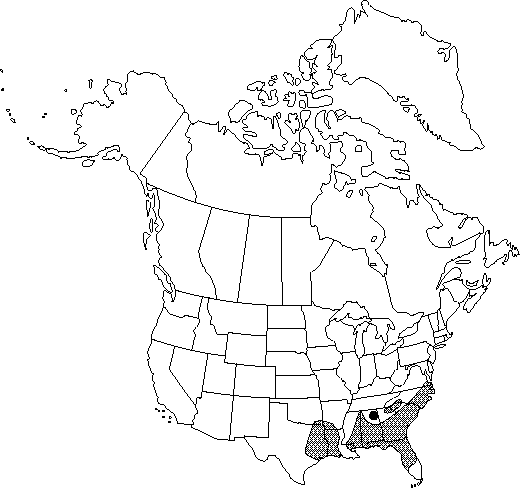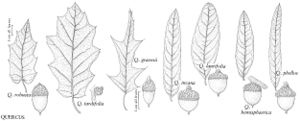Difference between revisions of "Quercus incana"
Travels Carolina, 378. 1791.
FNA>Volume Importer |
FNA>Volume Importer |
||
| Line 30: | Line 30: | ||
}}<!-- | }}<!-- | ||
| − | --><span class="statement" id="st- | + | --><span class="statement" id="st-undefined" data-properties=""><b>Trees,</b> deciduous, to 10 m. <b>Bark</b> dark brown to black with square plates. <b>Twigs</b> brown to reddish brown, 1-2.5 mm diam., tomentose to sparsely pubescent. <b>Terminal</b> buds light brown to reddish brown, narrowly ovoid to conic, 3.5-7 mm, distinctly 5-angled in cross section, scales pubescent, often tuft of reddish or silvery hairs at apex. <b>Leaves</b>: petiole 2-8(-10) mm, tomentose. <b>Leaf</b> blade narrowly ovate or elliptic to obovate, usually widest near middle, planar, 30-100 × 12-35 mm, base acute (rarely attenuate) to rounded, margins entire, with 1 apical awn (leaves on juvenile or 2d-flush growth may have 2-3 shallow lobes and 3-5 awns), apex acute or obtuse, rarely rounded; surfaces abaxially densely tomentose, hairs in vein axils often reddish, easily distinguished from others, adaxially often glossy, sparsely pubescent, especially along midrib and near base, veins often raised. <b>Acorns</b> biennial; cup saucer-shaped to bowl-shaped, 4.5-8 mm high × 10-18 mm wide, covering 1/4-1/3(-1/2) nut, outer surface pubescent or puberulent, inner surface uniformly pubescent, scale tips tightly appressed, obtuse or acute; nut ovoid (rarely subglobose) to broadly ellipsoid, 10-17 × 10-16 mm, occasionally striate, glabrate, scar diam. 5.5-10.5 mm.</span><!-- |
-->{{Treatment/Body | -->{{Treatment/Body | ||
| Line 61: | Line 61: | ||
|publication year=1791 | |publication year=1791 | ||
|special status=Endemic;Selected by author to be illustrated;Weedy | |special status=Endemic;Selected by author to be illustrated;Weedy | ||
| − | |source xml=https://jpend@bitbucket.org/aafc-mbb/fna- | + | |source xml=https://jpend@bitbucket.org/aafc-mbb/fna-data-curation.git/src/9216fc802291cd3df363fd52122300479582ede7/coarse_grained_fna_xml/V3/V3_966.xml |
|genus=Quercus | |genus=Quercus | ||
|section=Quercus sect. Lobatae | |section=Quercus sect. Lobatae | ||
|species=Quercus incana | |species=Quercus incana | ||
| − | |||
| − | |||
| − | |||
| − | |||
| − | |||
| − | |||
| − | |||
| − | |||
| − | |||
| − | |||
| − | |||
| − | |||
| − | |||
| − | |||
| − | |||
| − | |||
| − | |||
| − | |||
| − | |||
| − | |||
| − | |||
| − | |||
| − | |||
| − | |||
| − | |||
| − | |||
| − | |||
| − | |||
| − | |||
| − | |||
| − | |||
| − | |||
| − | |||
| − | |||
| − | |||
| − | |||
| − | |||
| − | |||
| − | |||
| − | |||
| − | |||
| − | |||
}}<!-- | }}<!-- | ||
-->[[Category:Treatment]][[Category:Quercus sect. Lobatae]] | -->[[Category:Treatment]][[Category:Quercus sect. Lobatae]] | ||
Revision as of 14:54, 27 July 2019
Trees, deciduous, to 10 m. Bark dark brown to black with square plates. Twigs brown to reddish brown, 1-2.5 mm diam., tomentose to sparsely pubescent. Terminal buds light brown to reddish brown, narrowly ovoid to conic, 3.5-7 mm, distinctly 5-angled in cross section, scales pubescent, often tuft of reddish or silvery hairs at apex. Leaves: petiole 2-8(-10) mm, tomentose. Leaf blade narrowly ovate or elliptic to obovate, usually widest near middle, planar, 30-100 × 12-35 mm, base acute (rarely attenuate) to rounded, margins entire, with 1 apical awn (leaves on juvenile or 2d-flush growth may have 2-3 shallow lobes and 3-5 awns), apex acute or obtuse, rarely rounded; surfaces abaxially densely tomentose, hairs in vein axils often reddish, easily distinguished from others, adaxially often glossy, sparsely pubescent, especially along midrib and near base, veins often raised. Acorns biennial; cup saucer-shaped to bowl-shaped, 4.5-8 mm high × 10-18 mm wide, covering 1/4-1/3(-1/2) nut, outer surface pubescent or puberulent, inner surface uniformly pubescent, scale tips tightly appressed, obtuse or acute; nut ovoid (rarely subglobose) to broadly ellipsoid, 10-17 × 10-16 mm, occasionally striate, glabrate, scar diam. 5.5-10.5 mm.
Phenology: Flowering spring.
Habitat: Well-drained sandy soils of barrens, hammocks, dunes, and upland ridges
Elevation: 0-250 m
Distribution

Ala., Ark., Fla., Ga., La., Miss., N.C., Okla., S.C., Tex., Va.
Discussion
Quercus incana reportedly hybridizes with Q. falcata [= Q. ×subintegra (Engelmann) Trelease], Q. hemisphaerica (D. M. Hunt 1989), Q. laurifolia (= Q. ×atlantica Ashe), Q. laevis (= Q. ×asheana Little), Q. marilandica (= Q. ×cravenensis Little), Q. nigra (= Q. ×caduca Trelease), and Q. phellos (E. J. Palmer 1948); with Q. pumila (D. M. Hunt 1989); and with Q. velutina (= Q. ×podophylla Trelease), and questionably, Q. myrtifolia.
Selected References
None.
